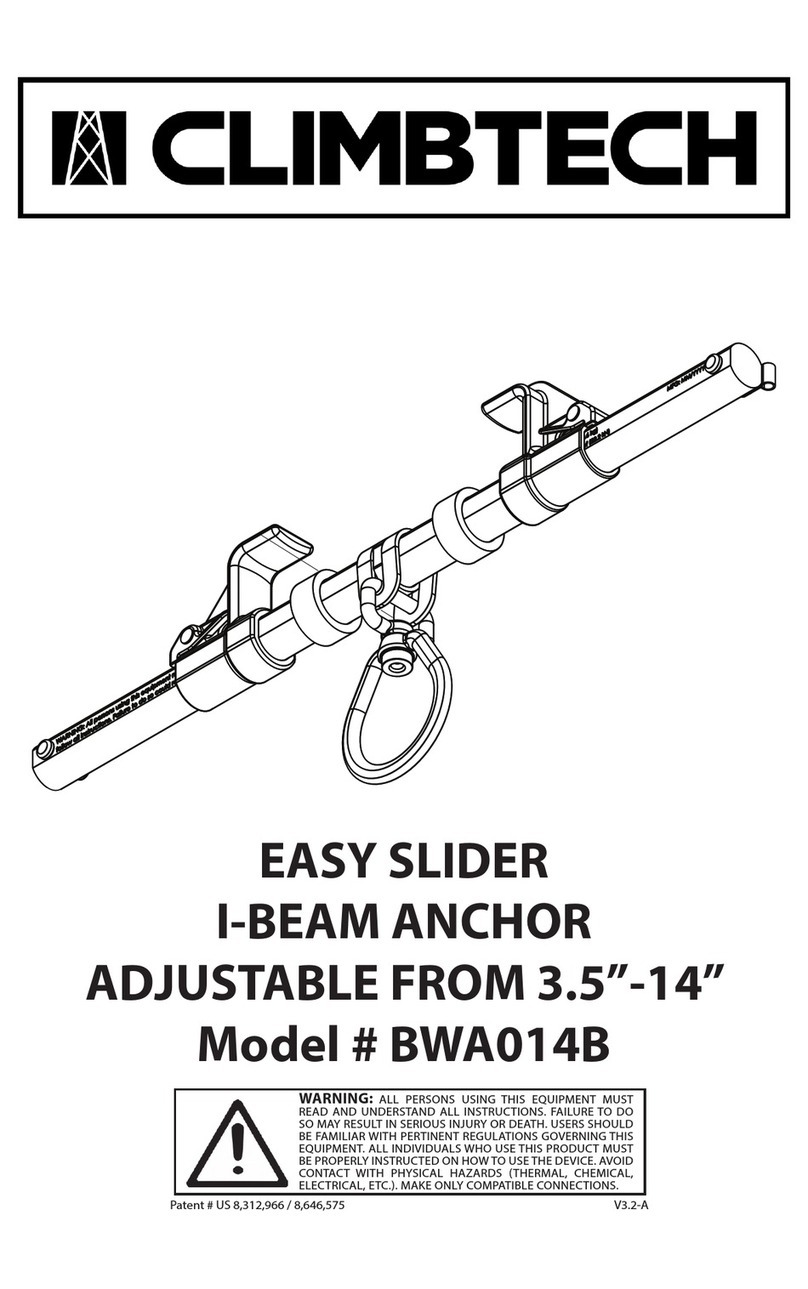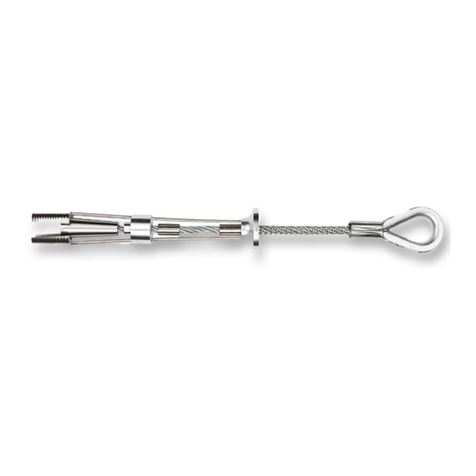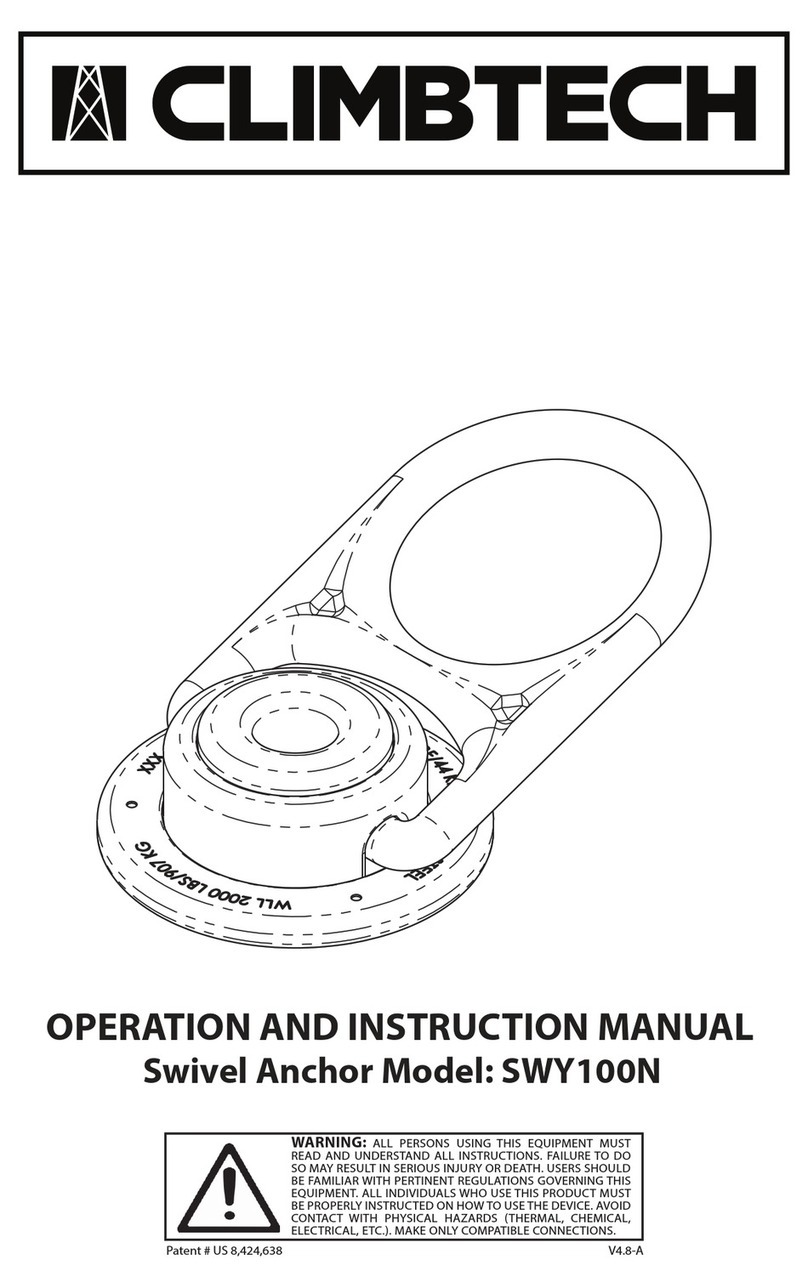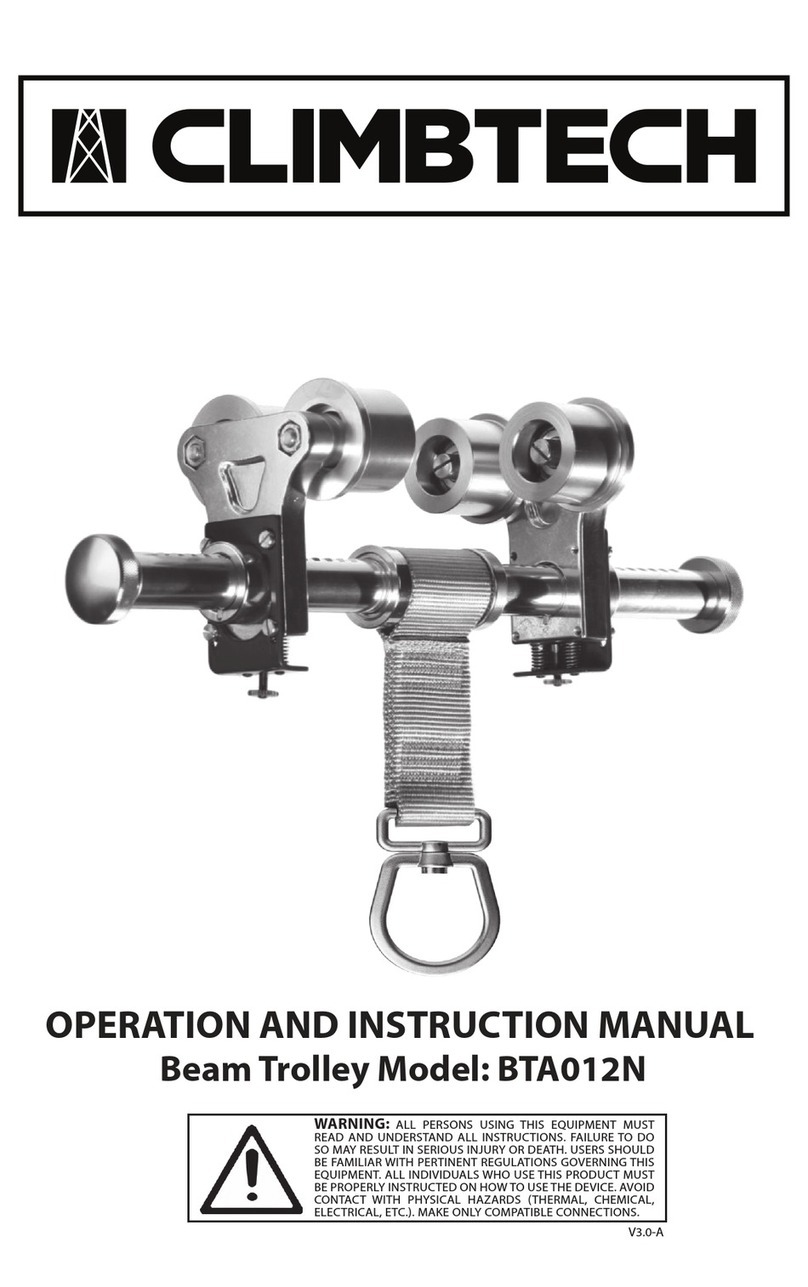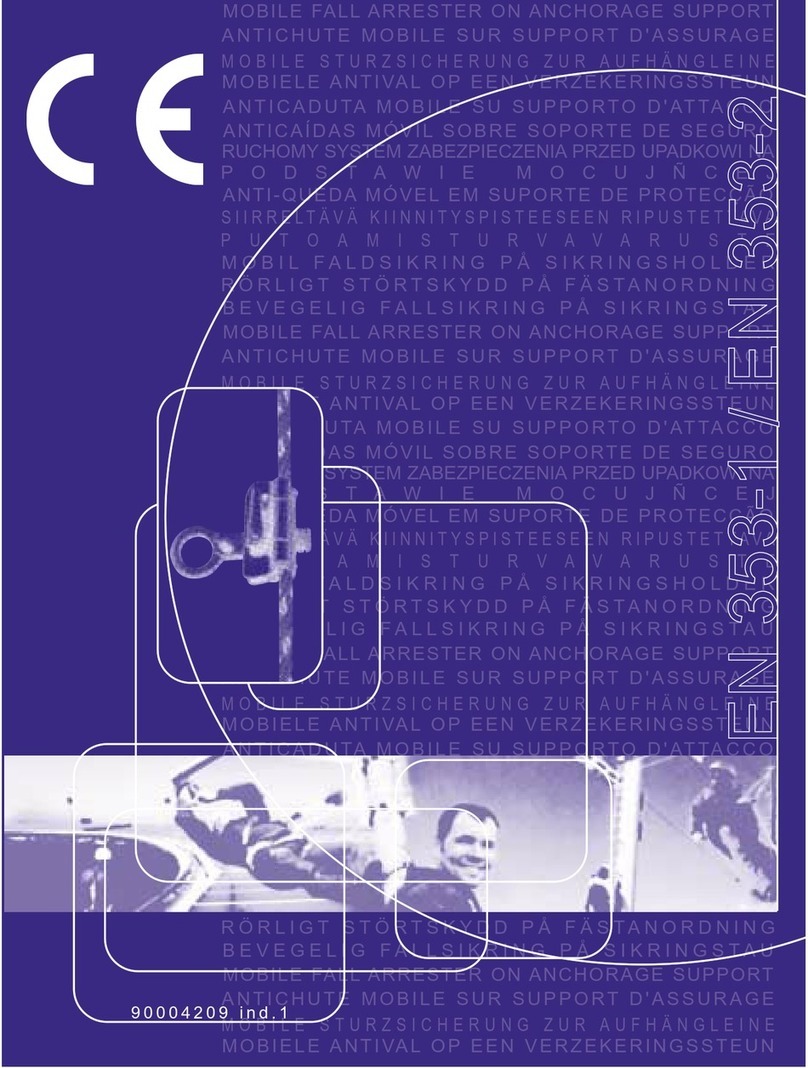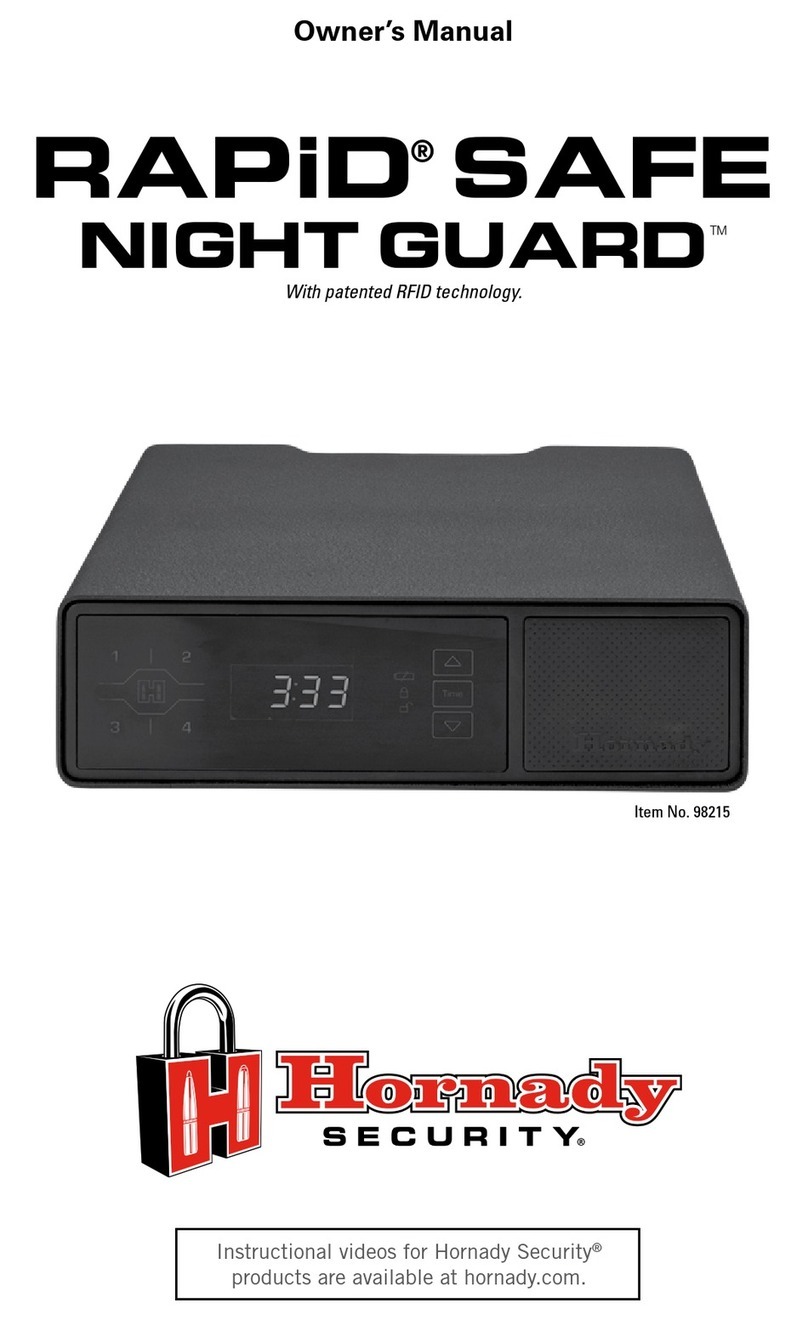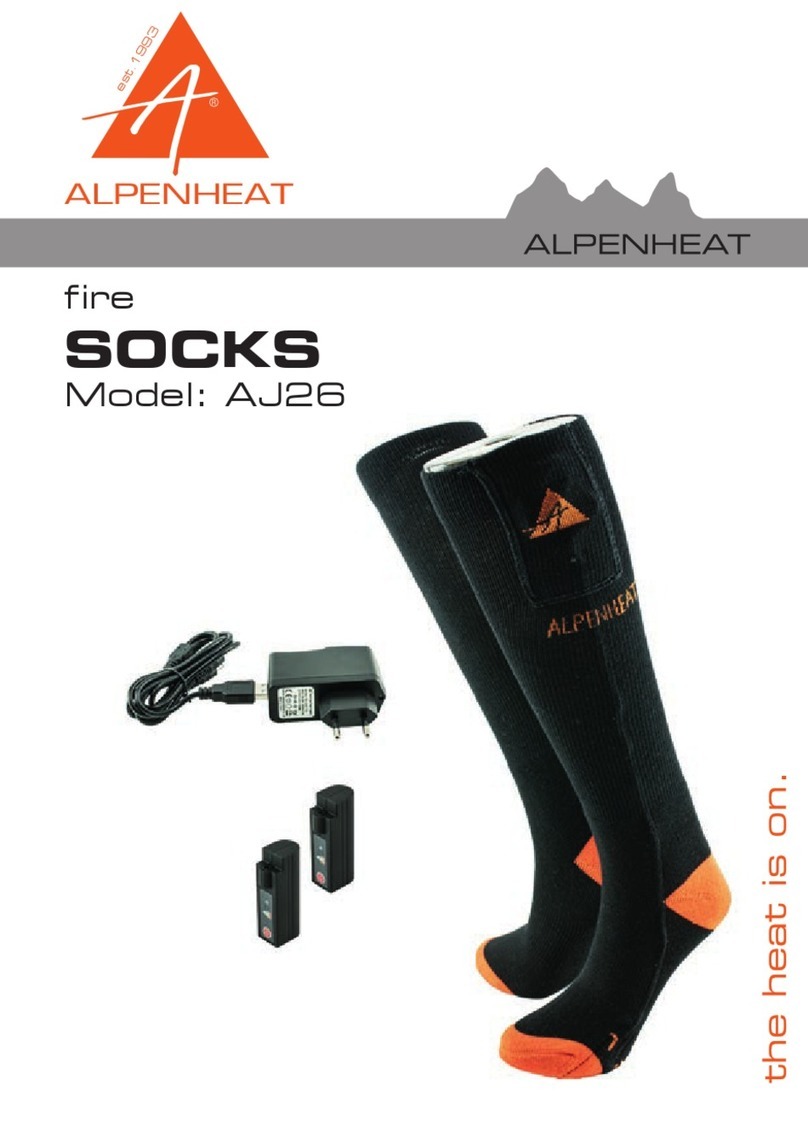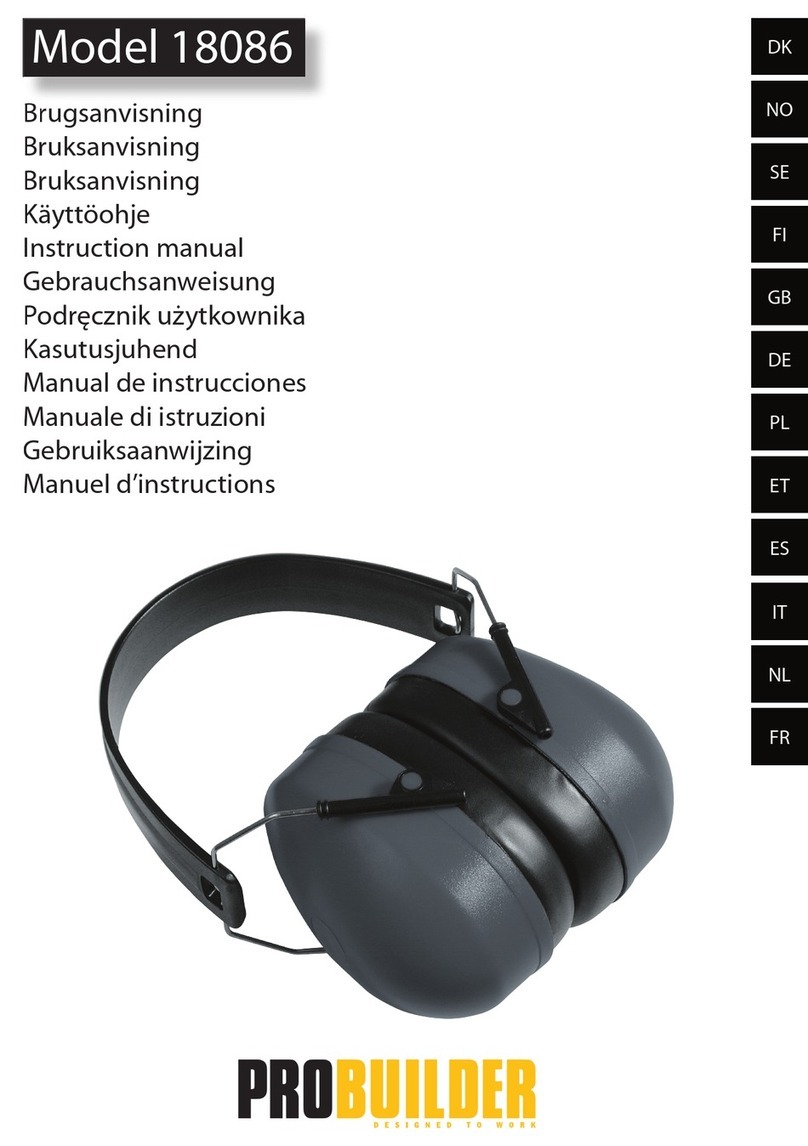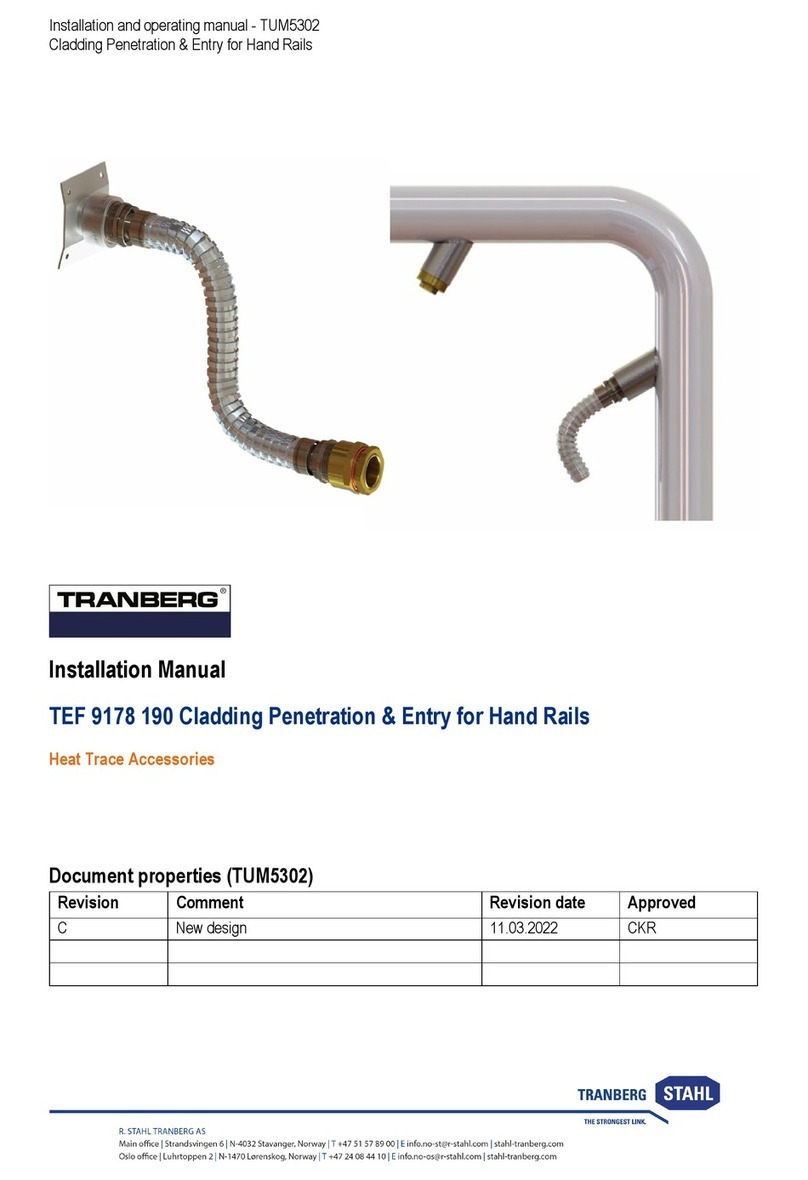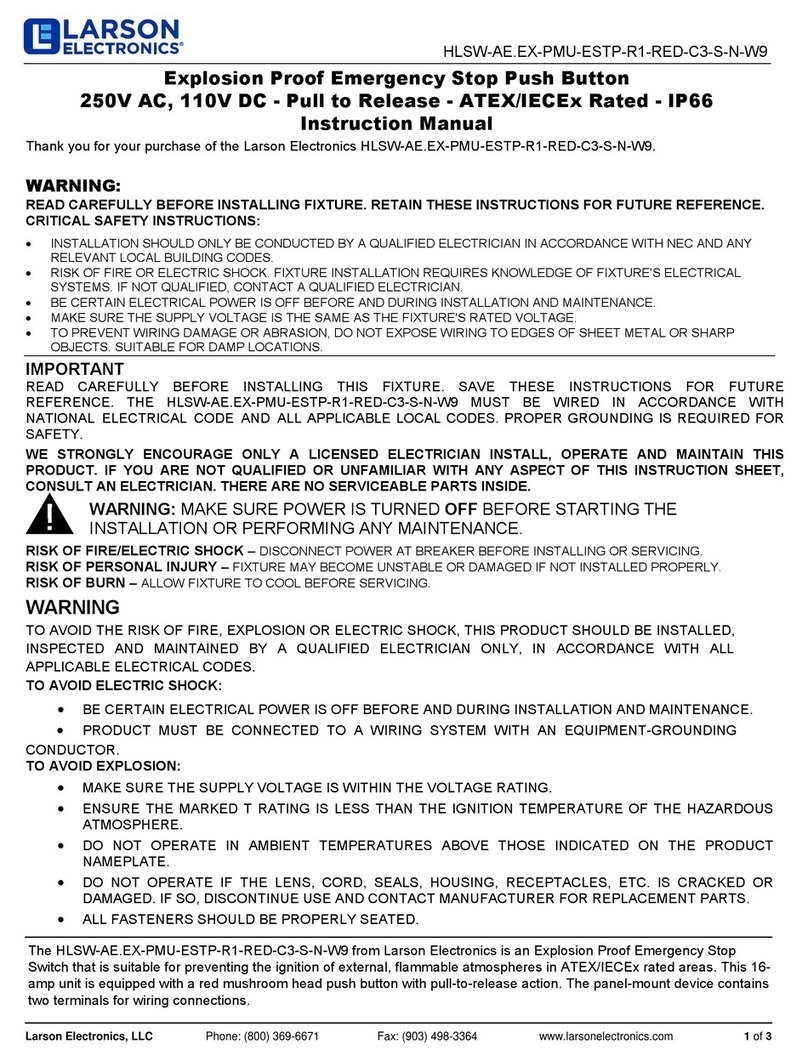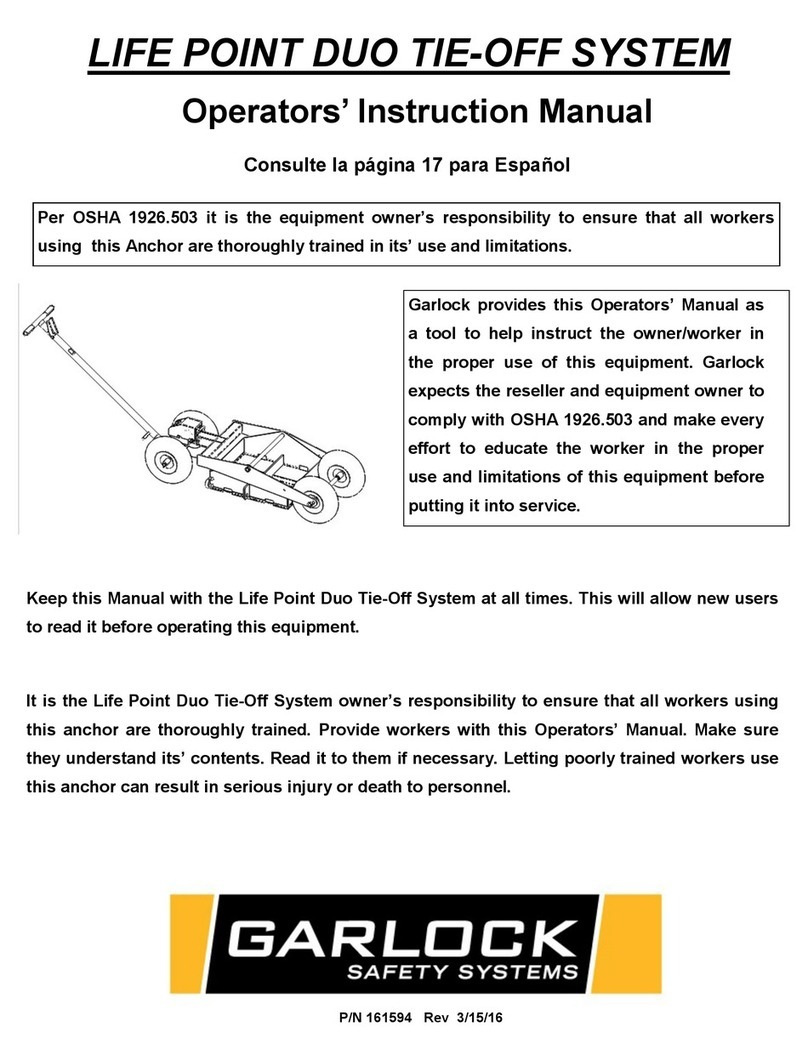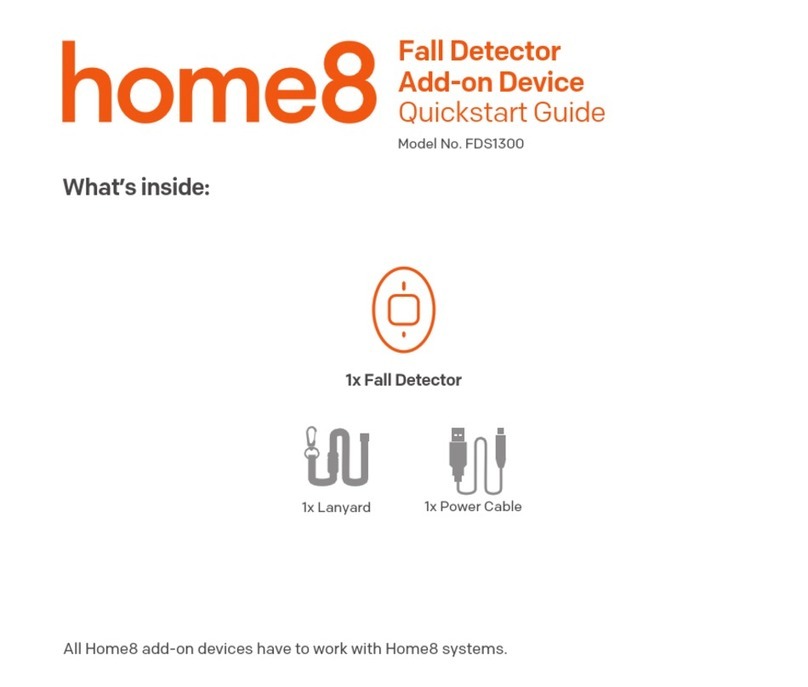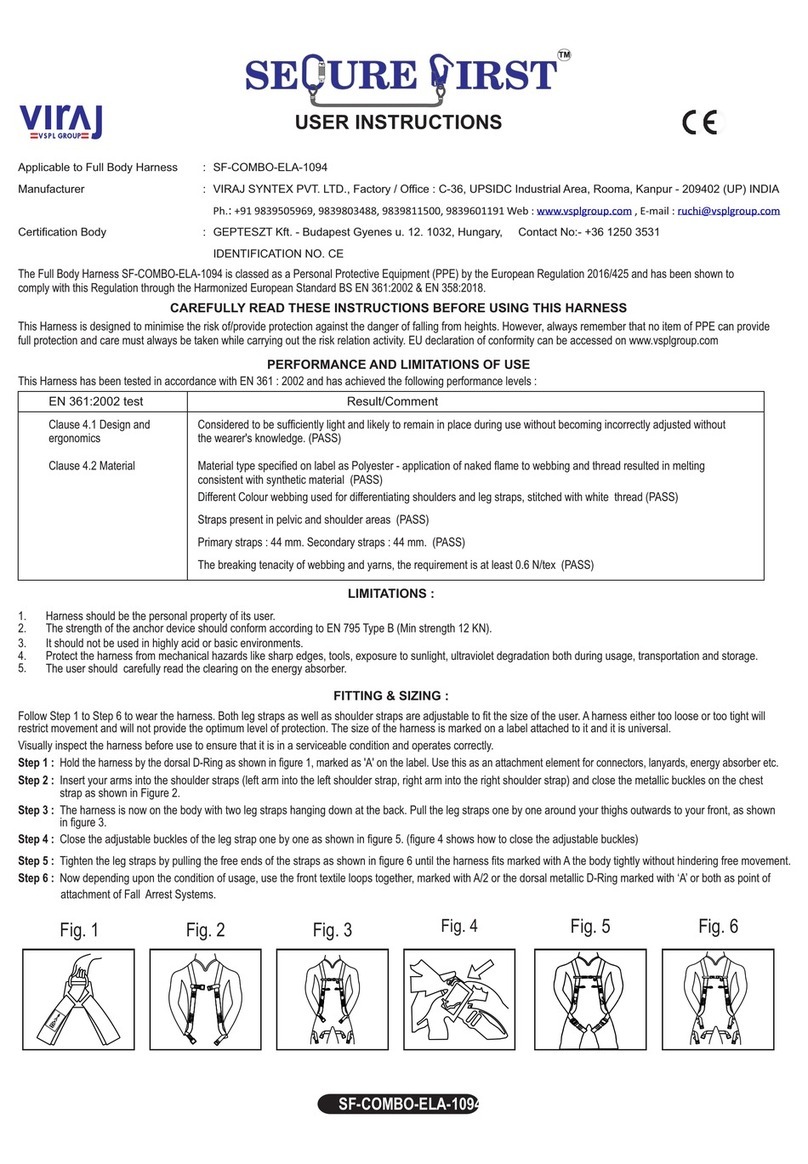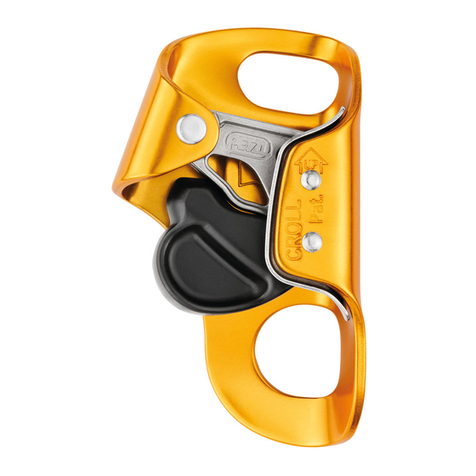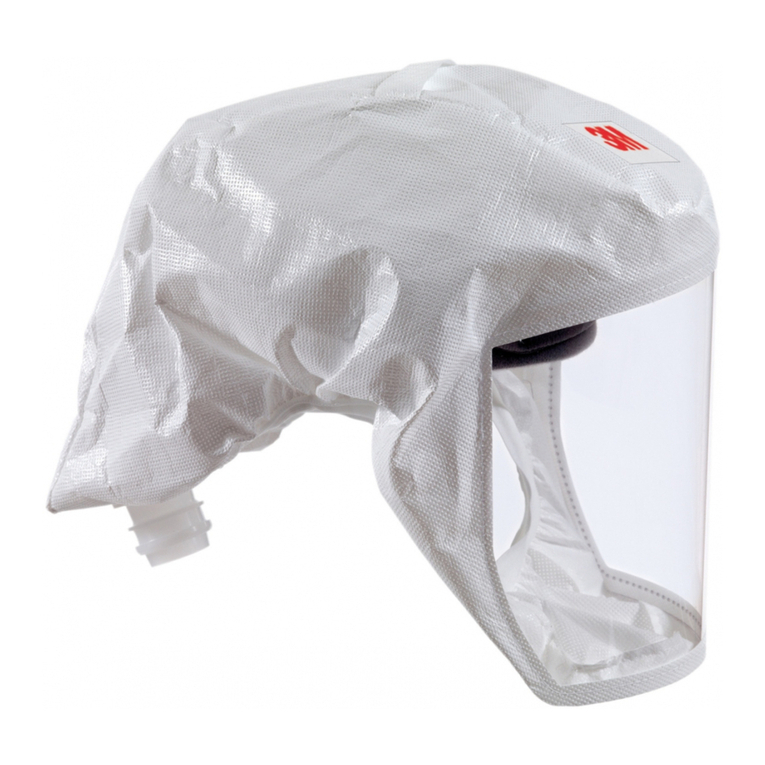ClimbTech Freetech HARNESS-XXX-FRT User manual

FreeTech Harness
Model: HARNESS-XXX-FRT
Made in the USA
IN DRAFT ONLY
V2.3
INSPECTION AND MAINTENANCE LOG
Part Number
MODEL NUMBER:
DATE OF MANUFACTURE:
Comments Inspector Name
Inspection:
Inspect the equipment according to your employer’s policy for inspecting fall
protection equipment. The equipment should be thoroughly inspected after each
use by an inspector that meets your organization’s training standard for inspection
of life safety equipment. Record the date of the inspection and the results in the
equipment log or on a tag that attaches to the equipment. Each user should be
trained in equipment inspection and should inspect the equipment before each use.
When inspecting the equipment, check the webbing and rope for cuts, worn
or frayed areas, broken bers, soft or hard spots, discoloration, or melted bers.
Check the stitching for pulled threads, abrasion, or breaks. Check the hardware for
damage, sharp edges, and improper operation. If any of the above is noted, or if the
equipment has been subjected to shock loads, fall loads, or abuse other than normal
use, remove the equipment from service and destroy it. If there is any doubt about
the serviceability of the equipment, remove the equipment from service and destroy
it.
The service life of equipment used for fall protection depends greatly on the type of
use and the environment of use. Because these factors vary greatly, a precise service
life of the equipment cannot be provided.
WARNING: Prior to donning the harness, inspect both the fall arrest indicator
located in proximity of the dorsal attachment point as well as the Switchpoint™
System release handle located at the right hip. If either the fall arrest indicator
or the release handle are damaged or show signs of being deployed, remove the
harness from service immediately.
Date
ClimbTech, LLC.
7303 Burleson Rd. Suite 901, Austin, TX 78744
1(512) 308-6440 / www.climbtech.com
Product Warranty, Limited Remedy and Limitation of Liability
WARRANTY: THE FOLLOWING IS MADE IN LIEU OF ALLWARRANTIES
OR CONDITIONS, EXPRESS OR IMPLIED, INCLUDINGTHE IMPLIED
WARRANTIES OR CONDITIONS OF MERCHANTABILITY OR FITNESS
FOR A PARTICULAR PURPOSE. Equipment oered by ClimbTech is
warranted against factory defects in workmanship and materials for a
period of one year from date of purchase.
LIMITED REMEDY: Upon notice in writing, ClimbTech will repair or
replace all defective items at ClimbTech’s sole discretion. ClimbTech
reserves the right to require that the defective item be returned to
its plant for inspection before determining the appropriate course of
action. Warranty does not cover equipment damage resulting from
wear, abuse, damage in transit, failure to maintain the product or other
damage beyond the control of ClimbTech. ClimbTech shall be the
sole judge of product condition and warranty options. This warranty
applies only to original purchaser and is the only warranty applicable
to this product. Please contact ClimbTech technical service department
for assistance.
LIMITATION OF LIABILITY: IN NO EVENT WILL CLIMBTECH BE LIABLE
FOR ANY INDIRECT, INCIDENTAL, SPECIAL OR CONSEQUENTIAL
DAMAGES INCLUDING, BUT NOT LIMITEDTO, LOSS OF PROFITS, IN
ANYWAY RELATED TOTHE PRODUCTS REGARDLESS OFTHE LEGAL
THEORY ASSERTED. ClimbTech, LLC.
7303 Burleson Rd. Suite 901, Austin, TX 78744
1(512) 308-6440 / www.climbtech.com
DRAFT
FAILURE TO COMPLY WITH INSTRUCTIONS OR IMPROPER USE OF THIS EQUIPMENT MAY RESULT IN SERIOUS INJURY
OR DEATH. THIS EQUIPMENT HAS BEEN DESIGNED AND MANUFACTURED FOR USE BY EXPERIENCED PROFESSIONALS
ONLY. DO NOT ATTEMPT TO USE THIS EQUIPMENT WITHOUT PROPER TRAINING. MANUFACTURER’S INSTRUCTIONS
SHALL BE PROVIDED TO THE USER. THOROUGHLY READ AND UNDERSTAND ALL LABELS AND INSTRUCTIONS BEFORE
USE. USE, INSPECT AND REPAIR ONLY IN ACCORDANCE WITH MANUFACTURER’S INSTRUCTIONS. DO NOT ALTER OR
MISUSE THIS EQUIPMENT. FOLLOW RECOMMENDED PROCEDURES FOR DONNING AND ADJUSTING THE HARNESS.
FOLLOW THE EMPLOYER’S SAFE WORKING PROCEDURES AT ALL TIMES WHEN USING THE HARNESS. THE USER SHALL
HAVE A RESCUE PLAN AND A MEANS TO IMPLEMENT IT WHEN USING THIS EQUIPMENT. THE USER SHALL KNOW AND
FOLLOW ALL APPLICABLE OSHA AND OTHER REGULATIONS PERTAINING TO OCCUPATIONAL SAFETY. ASSURE THAT
ANY COMBINATION OF COMPONENTS OR SUBSYSTEMS, OR BOTH, DO NOT INTERFERE WITH THE SAFE FUNCTION OF
EACH OTHER.DO NOT EXPOSE THE HARNESS TO CHEMICALS WHICH ARE HARMFUL TO NYLON. IF IN DOUBT, CONTACT
THE MANUFACTURER. AVOID CONTACT WITH SHARP EDGES OR ABRASIVE SURFACES. USE EXTREME CAUTION WHEN
USING THE HARNESS AROUND MOVING MACHINERY OR ELECTRICAL HAZARDS.
USER INFORMATION
User Information shall be provided to the user of the product. ClimbTech recommends separating the User Information
from the equipment and retaining the information in a permanent record. ClimbTech also recommends making a copy
of the information to keep with the equipment and that the information should be referred to before and after each
use.
USER INSPECTION, MAINTENANCE AND STORAGE OF EQUIPMENT
Users of personal fall arrest systems shall, at a minimum, comply with all manufacturer instructions regarding the
inspection, maintenance and storage of the equipment. The user’s organization shall retain the manufacturer’s
instructions and make them readily available to all users. See ANSI/ASSE Z359.2, Minimum Requirements for a
Comprehensive Managed Fall Protection Program, regarding user inspection, maintenance and storage of equipment.
1. In addition to the inspection requirements set forth in the manufacturer’s instructions, the equipment shall be
inspected by the user before each use and, additionally, by a competent person, other than the user, at interval
of no more than one year for:
• Absence or illegibility of markings.
• Absence of any elements aecting the equipment form, t or function.
• Evidence of defects in, or damage to, hardware elements including cracks, sharp edges, deformation, corrosion,
chemical attack, excessive heating, alteration and excessive wear.
• Evidence of defects in or damage to strap or ropes including fraying, unsplicing, unlaying, kinking, knotting,
roping, broken or pulled stitches, excessive elongation, chemical attack, excessive soiling, abrasion, alteration,
needed or excessive lubrication, excessive aging and excessive wear.
2. Inspection criteria for the equipment shall be set by the user’s organization. Such criteria for the equipment
shall equal or exceed the criteria established by this standard or the manufacturer’s instructions, whichever is
greater.
3. When inspection reveals defects in, damage to, or inadequate maintenance of equipment, the equipment shall
be permanently removed from service or undergo adequate corrective maintenance, by the original equipment
manufacturer or their designate, before return to service.
CARRYING, MAINTENANCE & STORAGE
During use, carrying and storage keep the equipment away from acids, alkalis, exhaust emissions, rust and strong
chemicals. Do not expose the equipment to ame or high temperatures. Carry the equipment where it will be
protected as the equipment could melt or burn and fail if exposed to ame or high temperatures. If the equipment
becomes soiled, it can be washed in cold water with a mild detergent that is safe for use with nylon and polyester. Dry
out of direct sunlight. Do not dry in an automatic dryer. Store in a cool, dry location. Do not store where the equipment
may be exposed to moist air, particularly where dissimilar metals are stored together.
REPAIR
All repair work shall be performed by the manufacturer. All other work or modications will void the warranty and
releases ClimbTech from all liability and responsibility as the manufacturer.
SAMPLE INSPECTION AND MAINTENANCE LOG
The sample log suggests records that should be maintained by the purchaser or user of rescue equipment.
MAINTENANCE AND STORAGE
1. Maintenance and storage of equipment shall be conducted by the user’s organization in accordance with the
manufacturer’s instructions. Unique issues, which may arise due to conditions of use, shall be addressed with the
manufacturer.
2. Equipment which is in need of, or scheduled for, maintenance shall be tagged as unusable and removed from
service.
3. Equipment shall be stored in a manner as to preclude damage from environmental factors such as temperature,
light, UV excessive moisture, oil, chemicals and their vapors or other degrading elements.
ReadThis Instruction Manual Carefully Before UsingThis

PUTTING ON YOUR HARNESS
1. Loosen all of the adjusting straps on the harness.
2. Open all of the quick connect buckles.
3. Don the harness as you would a vest.
4. Reconnect the chest, waist and leg loop buckles.
5. Adjust all of the straps to ensure a snug t.
6. Secure all loose webbing tails in the provided Web Keepers™. rom service in accordance
with the requirements of OSHA 29 CFR 1910.66 and 1926.502
WARNING: Make sure the straps are snug. This decreases the risk of additional injury in the
event of a fall and will prevent the quick-connect buckles from disconnecting.
USINGYOUR HARNESS
The FreeTech Harness is intended to be used for work at height fall protection according to
the ANSI/ASSE Z359 Fall Protection Code.
To prevent roll out when using ANSI Z359.12 compliant carabiners or snaphooks to attach
to an attachment point, use only locking models. It is the user’s responsibility to verify
equipment compatibility with components and sub-systems before use.
Consult with the current edition of ANSI/ASSE Z359. 11 and applicable State or Provincial
regulations governing occupational safety. The user should consider all component
extensions and allow clearance for an arrest to take place a safe distance away from the
ground or structure. A harness stretch factor of up to 18in (46cm) should be factored in while
calculating fall clearance.
LANYARD PARKING ELEMENT
If using a fall arrest lanyard or Y-lanyard, connect the lanyard snaphook to the lanyard parking
element located on the upper chest when not in use (unless otherwise connected to an
anchorage point). The lanyard parking element of the harness is intended to disengage in
the event that the lanyard is hung up or tangled during a fall or during normal use to prevent
creating a hazard.
DEPLOYINGTHE SWITCHPOINT SYSTEM
In the event of a fall, the unique function of the FreeTech Harness’s patented Switchpoint
System allows a user to transfer their weight from the dorsal D-ring to the secondary tether
connection at the front waist. The resulting seated position in the harness provides more
freedom of movement for the user post-fall. To deploy:
1. Open velcro pouch and grab red tab
2. Firmly grasp the red webbing of the release handle and pull out and away from your
body. The dorsal release strap will feed out of the release buckle at the right hip and your
weight will transfer to the secondary tether connected to the waist strap. This transfer
occurs quickly.
3. If the release buckle reengages the dorsal release strap before it completely feeds out of
the buckle, simply pull on the release handle again until the transfer is complete.
WARNING: If the waist buckle was not connected when donning the harness, transferring
to the secondary tether will result in suspension from the right hip, which may cause
signicant discomfort.
ANSI/ASSE Z359 REQUIREMENTS FOR PROPER USE AND MAINTENANCE OF FULL BODY
HARNESSES
1. It is essential that the users of this type of equipment receive proper training and
instruction, including detailed procedures for the safe use of such equipment in their work
application. ANSI/ASSE Z359.2, Minimum Requirements for a Comprehensive Managed Fall
Protection Program, establishes guidelines and requirements for an employer’s managed
fall protection program, including policies, duties and training; fall protection procedures;
eliminating and controlling fall hazards; rescue procedures; incident investigations and
evaluating program eectiveness.
2. Correct t of a Full Body Harness is essential to proper performance. Users must be trained
to select the size and maintain the t of their Full Body Harness.
3. Users must follow manufacturer’s instructions for proper t and sizing, paying particular
attention to ensure that buckles are connected and aligned correctly, leg straps and shoulder
straps are kept snug at all times, chest straps are located in the middle chest area and leg
straps are positioned and snug to avoid contact with the genitalia should a fall occur.
4. Full Body Harnesses which meet ANSI/ASSE Z359.11 are intended to be used with other
components of a Personal Fall Arrest system that limit maximum arrest forces to 1800
pounds (8 kN) or less.
5. Suspension intolerance, also called suspension trauma or orthostatic intolerance, is a
serious condition that can be controlled with good harness design, prompt rescue and post
fall suspension relief devices.
A conscious user may deploy a suspension relief device allowing the user to remove
tension from around the legs, freeing blood ow, which can delay the onset of suspension
intolerance. An attachment element extender is not intended to be attached directly to
an anchorage or anchorage connector for fall arrest. An energy absorber must be used to
limit maximum arrest forces to 1800 pounds (8 kN). The length of the attachment element
extender may aect free fall distances and free fall clearance calculations.
SECTIONS 10-16 PROVIDE ADDITIONAL INFORMATION CONCERNING THE LOCATION AND
USE OFVARIOUS ATTACHMENTS THAT MAY BE PROVIDED ONTHIS FALL PROTECTION
HARNESS
10. Dorsal – The dorsal attachment element shall be used as the primary fall arrest attachment,
unless the application allows the use of an alternate attachment. The dorsal attachment may also
be used for travel restraint or rescue. When supported by the dorsal attachment during a fall,
the design of the Full Body Harness shall direct load through the shoulder straps supporting the
user, and around the thighs. Supporting the user, post fall, by the dorsal attachment will result in
an upright body position with a slight lean to the front with some slight pressure to the lower
chest. Considerations should be made when choosing a sliding versus xed dorsal attachment
element. Sliding dorsal attachments are generally easier to adjust to dierent user sizes, and allow
a more vertical rest position post fall, but can increase FBH Stretch.
11. Sternal – The sternal attachment may be used as an alternative fall arrest attachment in
applications where the dorsal attachment is determined to be inappropriate by a competent
person, and where there is no chance to fall in a direction other than feet rst. Accepted practical
uses for a sternal attachment include, but are not limited to, ladder climbing with a guided
type fall arrester, ladder climbing with an overhead self-retracting lifeline for fall arrest, work
positioning and rope access. The sternal attachment may also be used for travel restraint or
rescue. When supported by the sternal attachment during a fall, the design of the Full Body
Harness shall direct load through the shoulder straps supporting the user, and around the thighs.
Supporting the user, post fall, by the sternal attachment will result in roughly a sitting or cradled
body position with weight concentrated on the thighs, buttocks and lower back. Supporting the
user during work positioning by this sternal attachment will result in an approximate upright
body position.
If the sternal attachment is used for fall arrest, the competent person evaluating the application
should take measures to ensure that a fall can only occur feet rst. This may include limiting
the allowable free fall distance. It may be possible for a sternal attachment incorporated into an
adjustable style chest strap to cause the chest strap to slide up and possibly choke the user during
a fall, extraction, suspension, etc. The competent person should consider Full Body Harness
models with a xed sternal attachment for these applications.
12. Frontal – The frontal attachment serves as a ladder climbing connection for guided type
fall arresters where there is no chance to fall in a direction other than feet rst, or may be used
for work positioning. Supporting the user, post fall or during work positioning, by the frontal
attachment will result in a sitting body position, with the upper torso upright, with weight
concentrated on the thighs and buttocks. When supported by the frontal attachment the design
of the Full Body Harness shall direct load directly around the thighs and under the buttocks by
means of the sub-pelvic strap. If the frontal attachment is used for fall arrest, the competent
person evaluating the application should take measures to ensure that a fall can only occur feet
rst. This may include limiting the allowable free fall distance.
13. Shoulder – The shoulder attachment elements shall be used as a pair, and are an acceptable
attachment for rescue and entry/retrieval. The shoulder attachment elements shall not be used
for fall arrest. It is recommended that the shoulder attachment elements be used in conjunction
with a yoke which incorporates a spreader element to keep the Full Body Harness shoulder straps
separate.
14. Waist, Rear – The waist, rear attachment shall be used solely for travel restraint. The waist, rear
attachment element shall not be used for fall arrest. Under no circumstances is it acceptable to
use the waist, rear attachment for purposes other than travel restraint. The waist, rear attachment
shall only be subjected to minimal loading through the waist of the user, and shall never be used
to support the full weight of the user.
15. Hip – The hip attachment elements shall be used as a pair, and shall be used solely for work
positioning. The hip attachment elements shall not be used for fall arrest. Hip attachments are
often used for work positioning by arborists, utility workers climbing poles and construction
workers tying rebar and climbing on form walls. Users are cautioned against using the hip
attachment elements (or any other rigid point on the Full Body Harness) to store the unused end
of a fall arrest lanyard, as this may cause a tripping hazard, or, in the case multiple leg lanyards,
could cause adverse loading to the Full Body Harness and the wearer through the unused portion
of the lanyard.
16. Suspension seat – The suspension seat attachment elements shall be used as a pair, and shall
be used solely for work positioning. The suspension seat attachment elements shall not be used
for fall arrest. Suspension seat attachments are often used for prolonged work activities where
the user is suspended, allowing the user to sit on the suspension seat formed between the two
attachment elements. An example of this use would be window washers on large buildings
16. Suspension seat – The suspension seat attachment elements shall be used as a pair, and shall be
used solely for work positioning. The suspension seat attachment elements shall not be used for fall
arrest. Suspension seat attachments are often used for prolonged work activities where the user is
suspended, allowing the user to sit on the suspension seat formed between the two attachment ele-
ments. An example of this use would be window washers on large buildings.
MODEL SIZE COLOR RATING
HARNESS-SML-FRT Small (5’0” to 6’0”) Custom ANSI Z359.11
HARNESS-MED-FRT Medium (5’4” to 6’4”) Custom ANSI Z359.11
HARNESS-LRG-FRT Large (5’8” to 6’8”) Custom ANSI Z359.11
6. Full Body Harness (FBH) Stretch, the amount the FBH component of a
personal fall arrest system will stretch and deform during a fall, can contribute
to the overall elongation of the system in stopping a fall. It is important to
include the increase in fall distance created by FBH Stretch, as well as the
FBH connector length, the settling of the user’s body in the FBH and all other
contributing factors when calculating total clearance required for a particular
fall arrest system.
7. When not in use, unused lanyard legs that are still attached to a Full Body
Harness D-ring should not be attached to a work positioning element or any
other structural element on the Full Body Harness unless deemed acceptable
by the competent person and manufacturer of the lanyard. This is especially
important when using some types of “Y” style lanyards, as some load may
be transmitted to the user through the unused lanyard leg if it is not able to
release from the harness. The lanyard parking attachment is generally located
in the sternal area to help reduce tripping and entanglement hazards.
8. Loose ends of straps can get caught in machinery or cause accidental
disengagement of an adjuster. All Full Body Harnesses shall include keepers or
other components which serve to control the loose ends of straps.
9. Due to the nature of soft loop connections, it is recommended that soft
loop attachments only be used to connect with other soft loops or carabiners.
Snaphooks should not be used unless approved for the application by the
manufacturer.
1. Dorsal Position
From the dorsal position
in a post-fall scenario,
simply deploy the
SwitSwitchPoint™
System.
2. Seated Position
When the SwitchPoint™
System is deployed,
the FreeTech™ Harness
automatically reorients the
user into a seated position.
DRAFT
PERFORMANCE:
Maximum Capacity: One worker with
max weight of 310-lbs
Weight: 11.5lbs with seat
REGULATORY COMPLIANCE:
ANSI /ASSE Z359.11-2014
Other ClimbTech Safety Equipment manuals
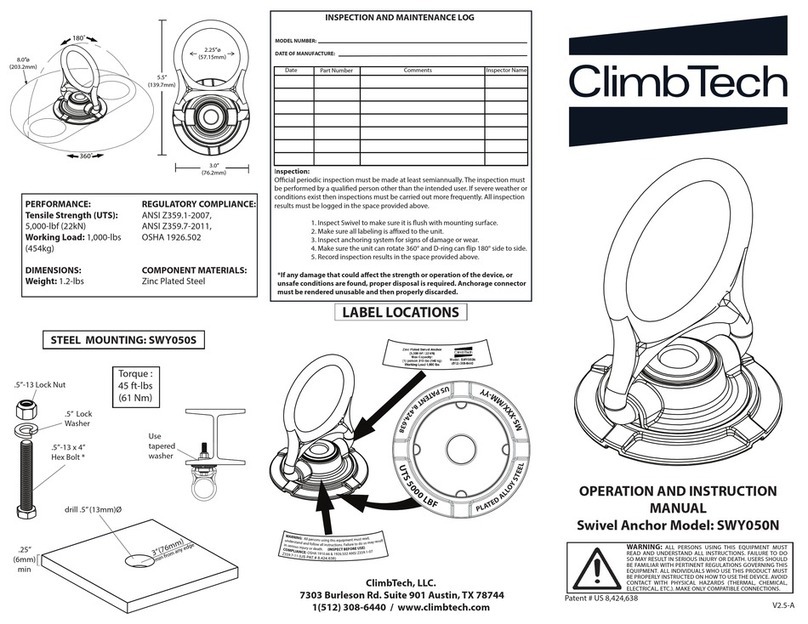
ClimbTech
ClimbTech SWY050N Guide
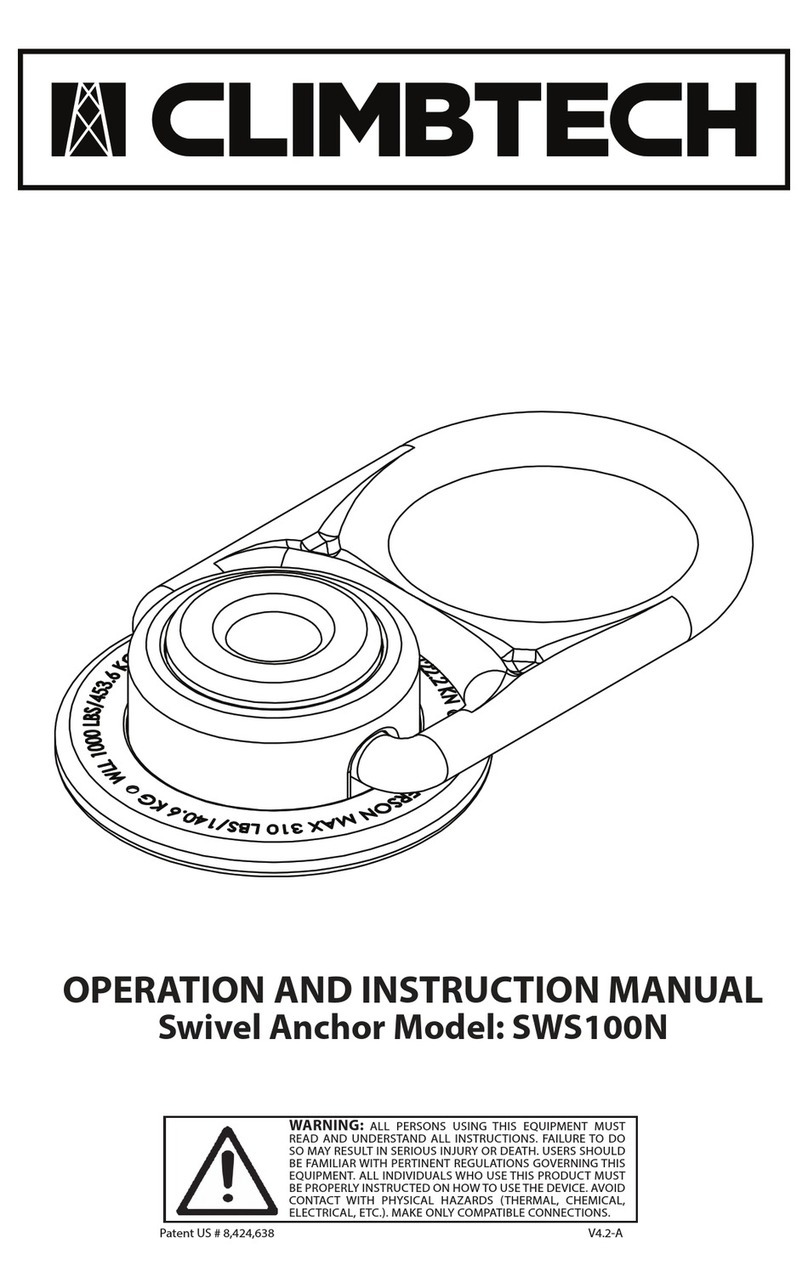
ClimbTech
ClimbTech SWS100N Guide
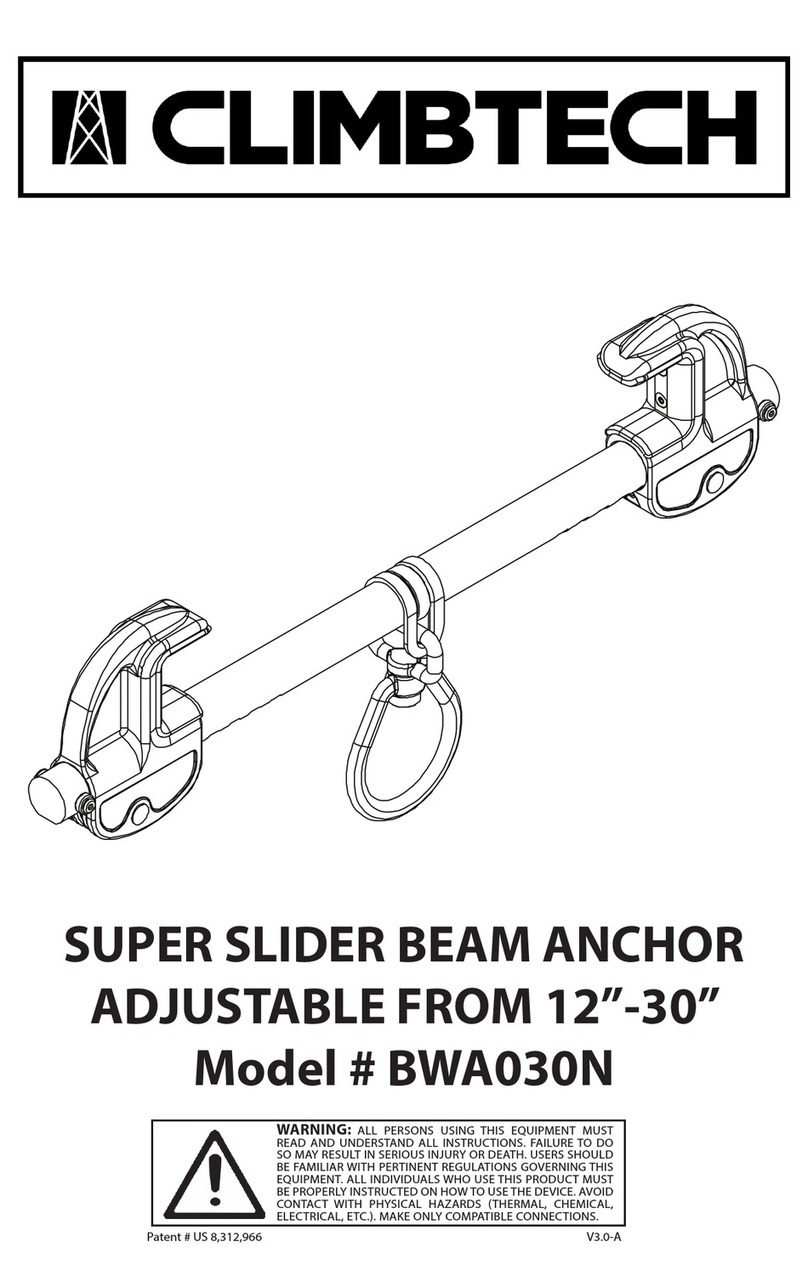
ClimbTech
ClimbTech BWA030N User manual
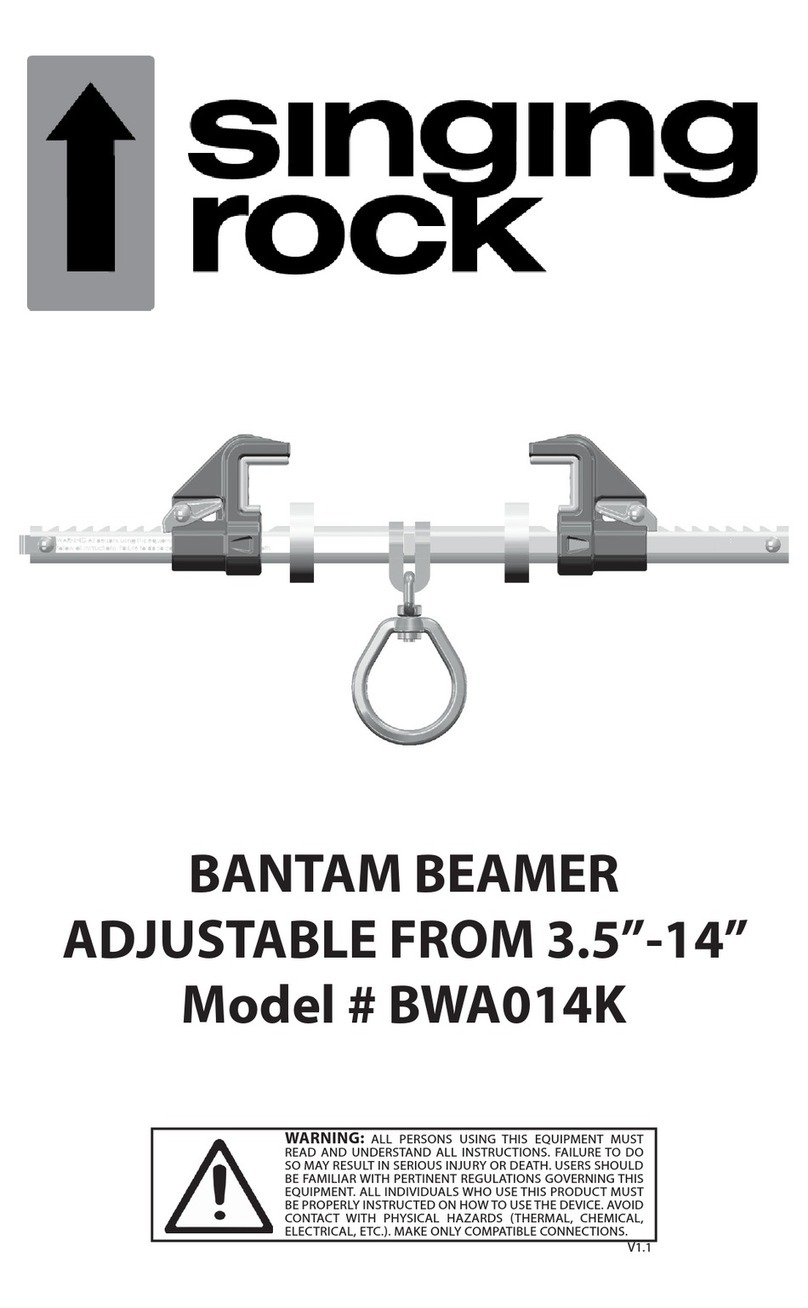
ClimbTech
ClimbTech BWA014K User manual
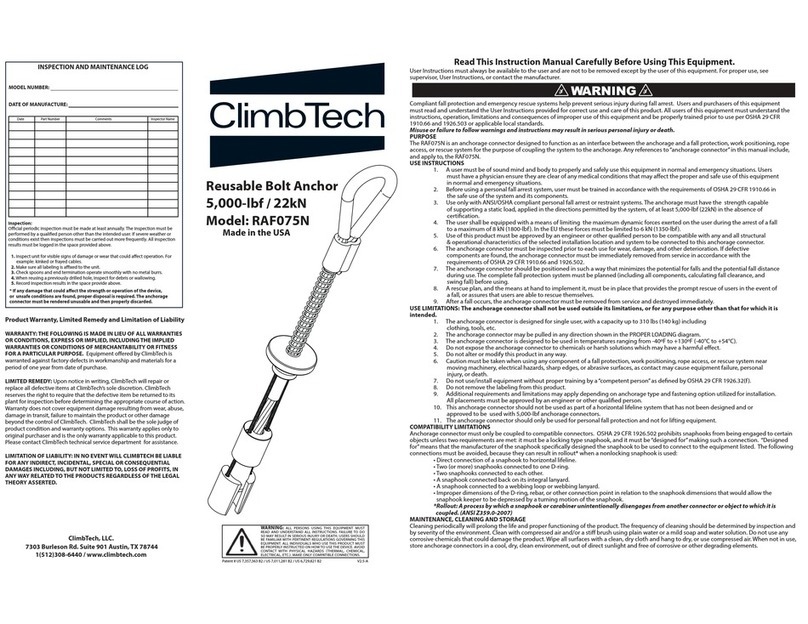
ClimbTech
ClimbTech RAF075N User manual

ClimbTech
ClimbTech BWA012N User manual
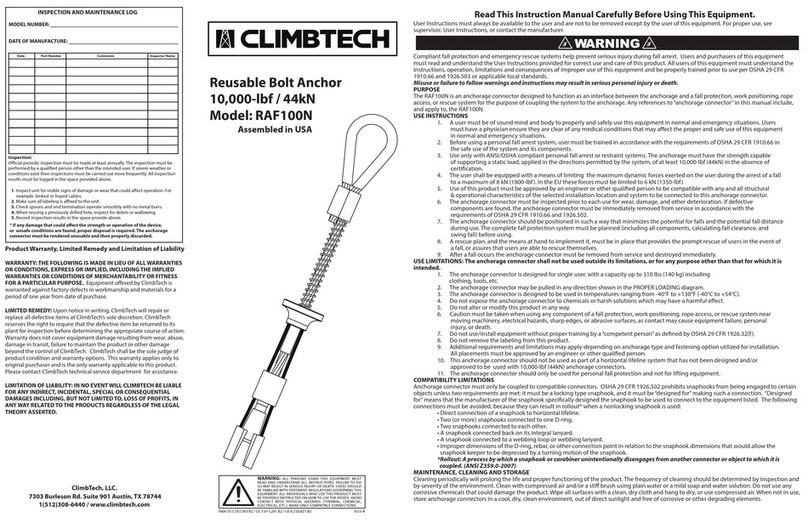
ClimbTech
ClimbTech RAF100N User manual
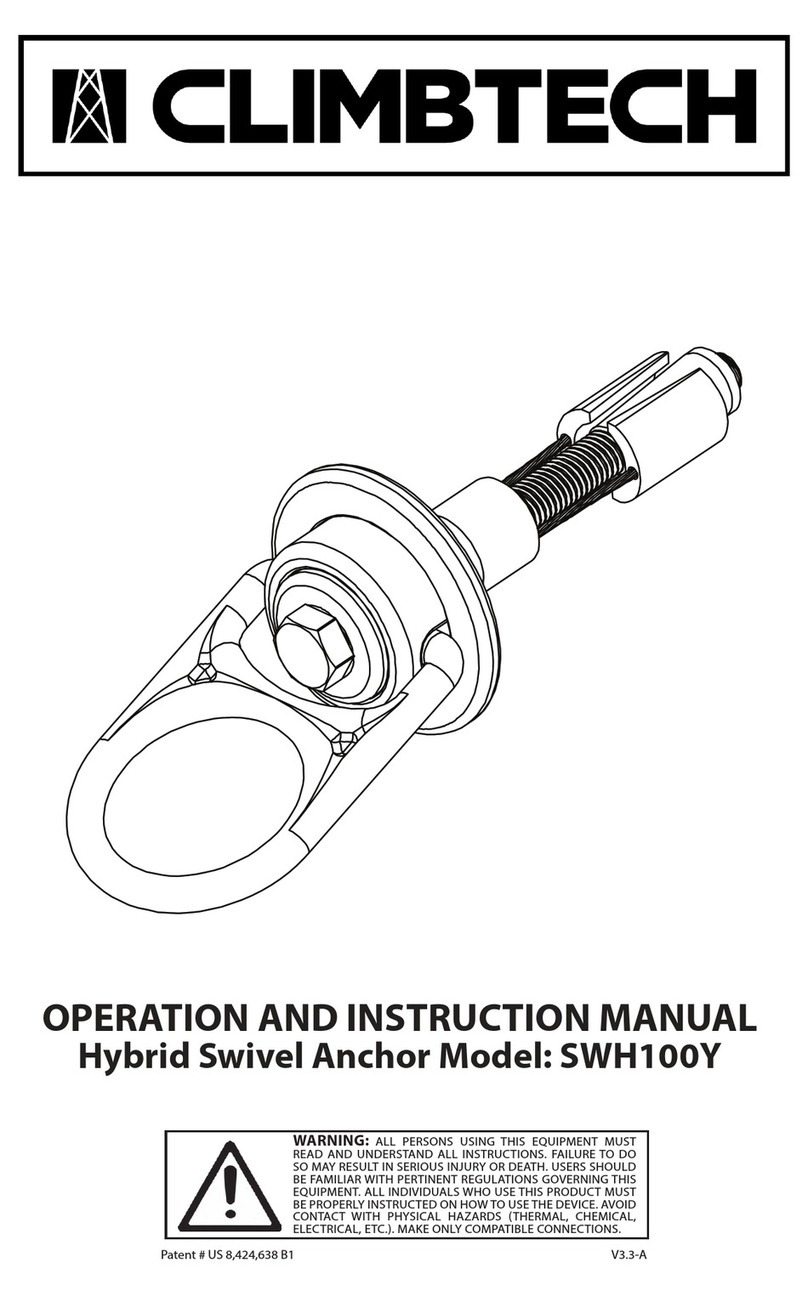
ClimbTech
ClimbTech SWH100Y Guide
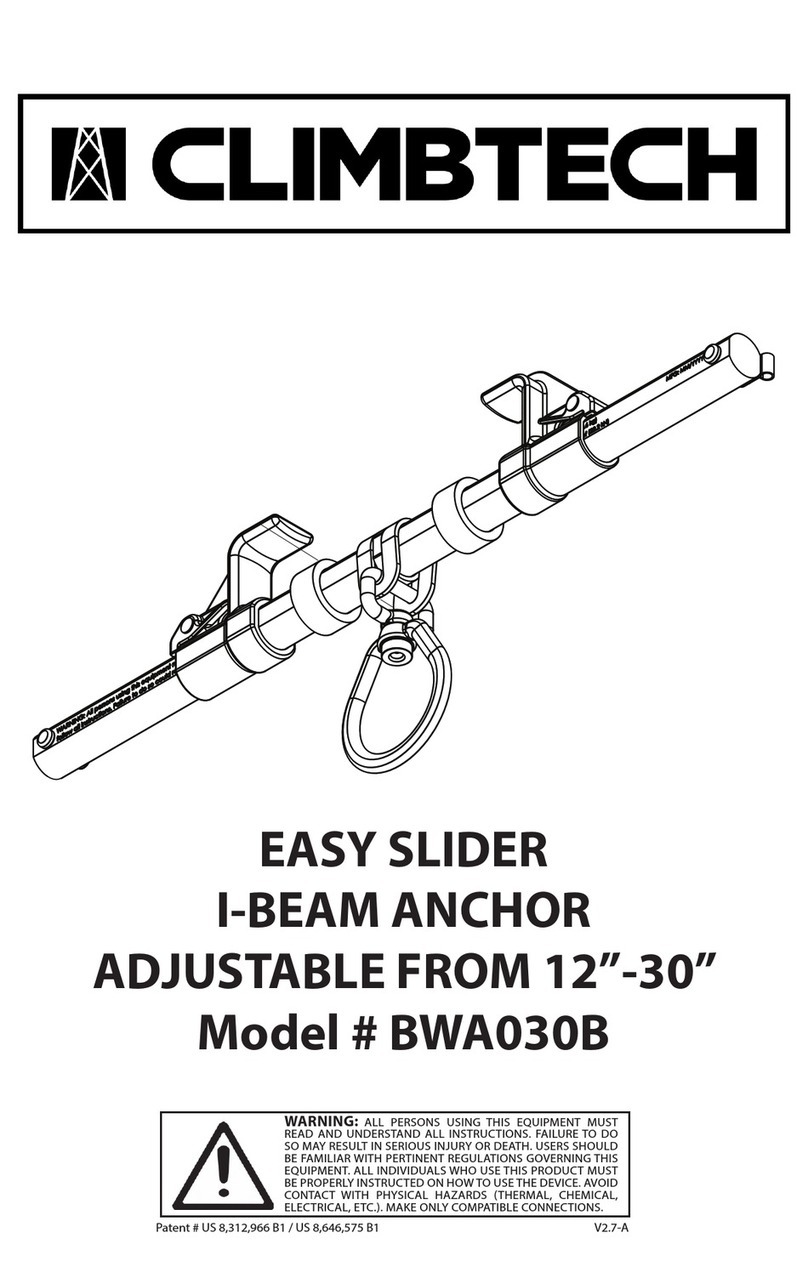
ClimbTech
ClimbTech BWA030B User manual
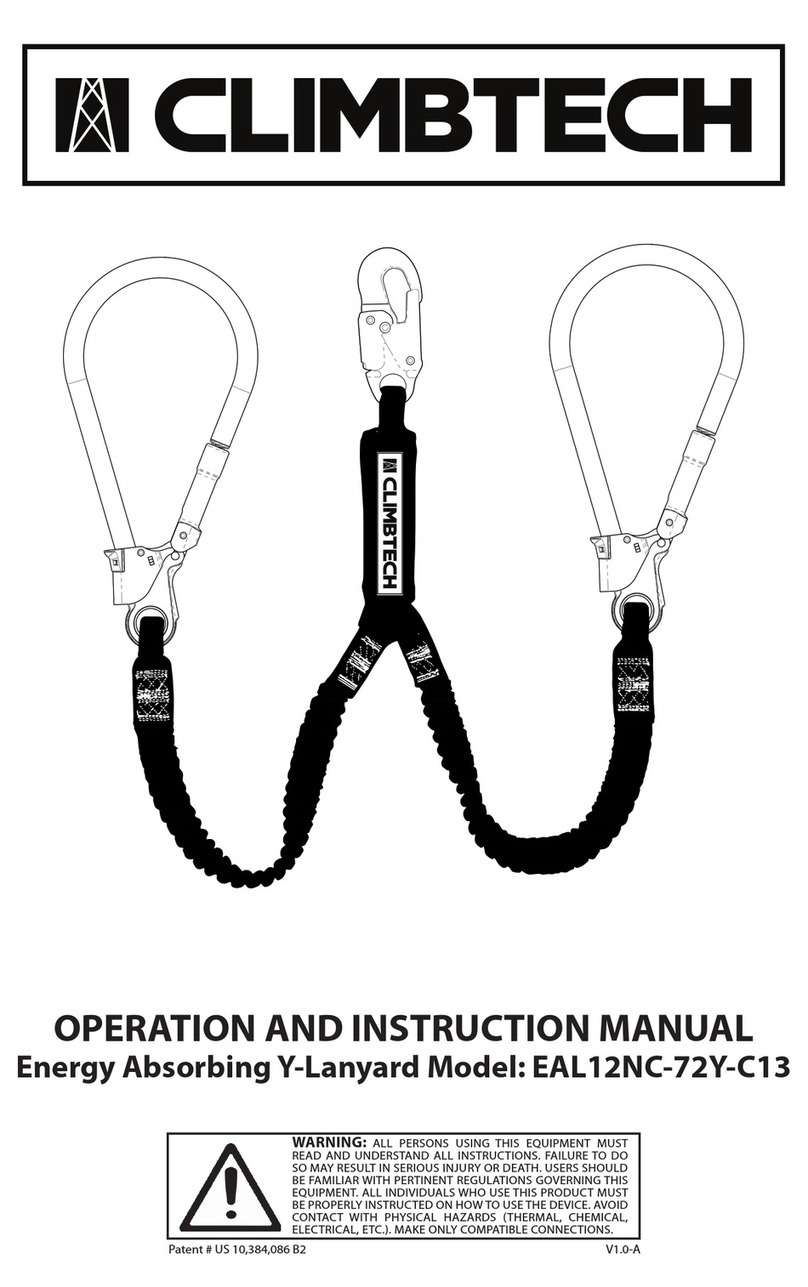
ClimbTech
ClimbTech EAL12NC-72Y-C13 Guide

